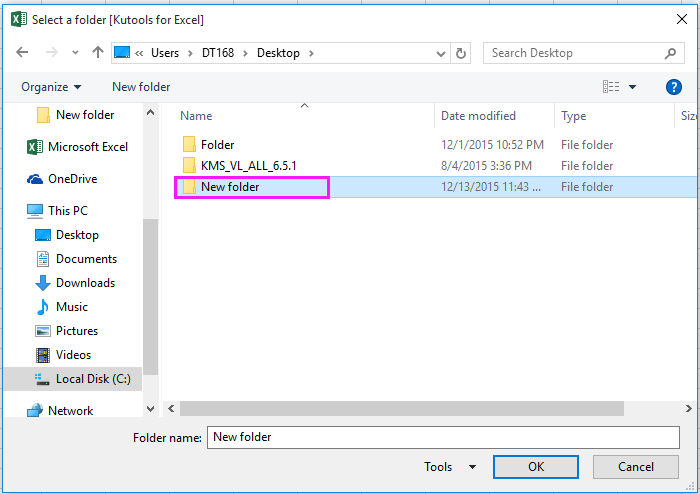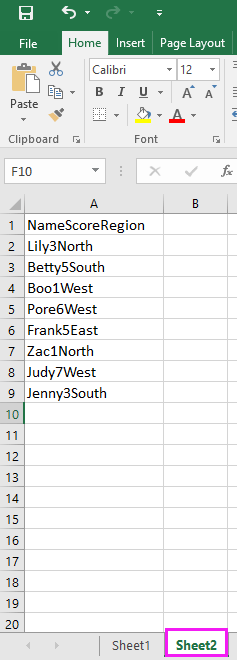如何在 Excel 中快速批量匯入多個 csv/文字/xml 文件?
在 Excel 中,您可能曾經嘗試將工作簿另存為 csv 文件、文字文件或 xml 文件,但您是否嘗試過從資料夾中匯入多個 csv/文字/xml 文件到一個工作簿或工作表中呢?本文介紹了一些快速批量匯入這些文件的方法。
使用 VBA 將資料夾中的多個文字文件匯入到工作簿的每個工作表中
要從資料夾中匯入文字文件到工作簿,您可以使用以下 VBA 快速處理。
1. 啟用空白工作簿,並按下 Alt + F11 鍵打開 Microsoft Visual Basic for Applications 視窗。
2. 點擊 插入 > 模組,並將 VBA 粘貼到模組視窗中。
VBA:從資料夾匯入所有文字文件到工作簿
Sub LoadPipeDelimitedFiles()
'UpdatebyKutoolsforExcel20151214
Dim xStrPath As String
Dim xFileDialog As FileDialog
Dim xFile As String
Dim xCount As Long
On Error GoTo ErrHandler
Set xFileDialog = Application.FileDialog(msoFileDialogFolderPicker)
xFileDialog.AllowMultiSelect = False
xFileDialog.Title = "Select a folder [Kutools for Excel]"
If xFileDialog.Show = -1 Then
xStrPath = xFileDialog.SelectedItems(1)
End If
If xStrPath = "" Then Exit Sub
Application.ScreenUpdating = False
xFile = Dir(xStrPath & "\*.txt")
Do While xFile <> ""
xCount = xCount + 1
Sheets(xCount).Select
With ActiveSheet.QueryTables.Add(Connection:="TEXT;" _
& xStrPath & "\" & xFile, Destination:=Range("A1"))
.Name = "a" & xCount
.FieldNames = True
.RowNumbers = False
.FillAdjacentFormulas = False
.PreserveFormatting = True
.RefreshOnFileOpen = False
.RefreshStyle = xlInsertDeleteCells
.SavePassword = False
.SaveData = True
.AdjustColumnWidth = True
.RefreshPeriod = 0
.TextFilePromptOnRefresh = False
.TextFilePlatform = 437
.TextFileStartRow = 1
.TextFileParseType = xlDelimited
.TextFileTextQualifier = xlTextQualifierDoubleQuote
.TextFileConsecutiveDelimiter = False
.TextFileTabDelimiter = False
.TextFileSemicolonDelimiter = False
.TextFileCommaDelimiter = False
.TextFileSpaceDelimiter = False
.TextFileOtherDelimiter = "|"
.TextFileColumnDataTypes = Array(1, 1, 1)
.TextFileTrailingMinusNumbers = True
.Refresh BackgroundQuery:=False
xFile = Dir
End With
Loop
Application.ScreenUpdating = True
Exit Sub
ErrHandler:
MsgBox "no files txt", , "Kutools for Excel"
End Sub3. 按下 F5 鍵或 執行按鈕來運行 VBA,並在彈出的對話框中選擇要匯入文字文件的資料夾。請參閱截圖:

4. 點擊 確定,所選資料夾中的每個文字文件都已匯入到活動工作簿的一個工作表中。請參閱截圖:



使用 Kutools AI 解鎖 Excel 的魔法
- 智能執行:執行單元格操作、分析數據並創建圖表——所有這些都由簡單的指令驅動。
- 自訂公式:生成量身定制的公式,簡化您的工作流程。
- VBA 編碼:輕鬆編寫和實現 VBA 代碼。
- 公式解釋:輕鬆理解複雜的公式。
- 文本翻譯:打破電子表格中的語言障礙。
使用 VBA 將資料夾中的多個 csv 文件匯入到單一工作表中
要將資料夾中的所有 csv 文件匯入到單一工作表中,可以使用以下 VBA 代碼。
1. 啟用空白工作表,並按下 Alt + F11 鍵打開 Microsoft Visual Basic for Applications 視窗。
2. 點擊 插入 > 模組,並將以下 VBA 粘貼到新的 模組視窗中。
VBA:從資料夾匯入 csv 文件到一個工作表中
Sub ImportCSVsWithReference()
'UpdatebyKutoolsforExcel20151214
Dim xSht As Worksheet
Dim xWb As Workbook
Dim xStrPath As String
Dim xFileDialog As FileDialog
Dim xFile As String
On Error GoTo ErrHandler
Set xFileDialog = Application.FileDialog(msoFileDialogFolderPicker)
xFileDialog.AllowMultiSelect = False
xFileDialog.Title = "Select a folder [Kutools for Excel]"
If xFileDialog.Show = -1 Then
xStrPath = xFileDialog.SelectedItems(1)
End If
If xStrPath = "" Then Exit Sub
Set xSht = ThisWorkbook.ActiveSheet
If MsgBox("Clear the existing sheet before importing?", vbYesNo, "Kutools for Excel") = vbYes Then xSht.UsedRange.Clear
Application.ScreenUpdating = False
xFile = Dir(xStrPath & "\" & "*.csv")
Do While xFile <> ""
Set xWb = Workbooks.Open(xStrPath & "\" & xFile)
Columns(1).Insert xlShiftToRight
Columns(1).SpecialCells(xlBlanks).Value = ActiveSheet.Name
ActiveSheet.UsedRange.Copy xSht.Range("A" & Rows.Count).End(xlUp).Offset(1)
xWb.Close False
xFile = Dir
Loop
Application.ScreenUpdating = True
Exit Sub
ErrHandler:
MsgBox "no files csv", , "Kutools for Excel"
End Sub3. 按下 F5 鍵或點擊 執行 按鈕來執行 VBA,並彈出對話框以選擇要匯入所有 csv 文件的資料夾。請參閱截圖:

4. 點擊 確定,並彈出對話框提醒您是否在匯入前清除活動工作表的內容,這裡我點擊 是。請參閱截圖:

點擊 是 後,所選資料夾中的所有 csv 文件都被匯入到當前工作表中,並且數據從 A 列開始向右排列。請參閱截圖:


提示:如果您想水平放置 csv 文件在工作表中,可以使用以下 VBA。
Sub ImportCSVsWithReferenceI()
'UpdatebyKutoolsforExcel20151214
Dim xSht As Worksheet
Dim xWb As Workbook
Dim xStrPath As String
Dim xFileDialog As FileDialog
Dim xFile As String
Dim xCount As Long
On Error GoTo ErrHandler
Set xFileDialog = Application.FileDialog(msoFileDialogFolderPicker)
xFileDialog.AllowMultiSelect = False
xFileDialog.Title = "Select a folder [Kutools for Excel]"
If xFileDialog.Show = -1 Then
xStrPath = xFileDialog.SelectedItems(1)
End If
If xStrPath = "" Then Exit Sub
Set xSht = ThisWorkbook.ActiveSheet
If MsgBox("Clear the existing sheet before importing?", vbYesNo, "Kutools for Excel") = vbYes Then
xSht.UsedRange.Clear
xCount = 1
Else
xCount = xSht.Cells(3, Columns.Count).End(xlToLeft).Column + 1
End If
Application.ScreenUpdating = False
xFile = Dir(xStrPath & "\" & "*.csv")
Do While xFile <> ""
Set xWb = Workbooks.Open(xStrPath & "\" & xFile)
Rows(1).Insert xlShiftDown
Range("A1") = ActiveSheet.Name
ActiveSheet.UsedRange.Copy xSht.Cells(1, xCount)
xWb.Close False
xFile = Dir
xCount = xSht.Cells(3, Columns.Count).End(xlToLeft).Column + 1
Loop
Application.ScreenUpdating = True
Exit Sub
ErrHandler:
MsgBox "no files csv", , "Kutools for Excel"
End Sub 
使用 VBA 將資料夾中的多個 xml 文件匯入到單一工作表中
如果您想將資料夾中的所有 XML 文件匯入到單一工作表中,可以使用以下 VBA 代碼。
1. 選擇要放置匯入數據的空白工作表,並按下 Alt + F11 鍵啟動 Microsoft Visual Basic for Applications 視窗。
2. 點擊 插入 > 模組,將 VBA 代碼粘貼到模組視窗中。
VBA:從資料夾匯入 XML 文件到工作表中。
Sub From_XML_To_XL()
'UpdatebyKutoolsforExcel20151214
Dim xWb As Workbook
Dim xSWb As Workbook
Dim xStrPath As String
Dim xFileDialog As FileDialog
Dim xFile As String
Dim xCount As Long
On Error GoTo ErrHandler
Set xFileDialog = Application.FileDialog(msoFileDialogFolderPicker)
xFileDialog.AllowMultiSelect = False
xFileDialog.Title = "Select a folder [Kutools for Excel]"
If xFileDialog.Show = -1 Then
xStrPath = xFileDialog.SelectedItems(1)
End If
If xStrPath = "" Then Exit Sub
Application.ScreenUpdating = False
Set xSWb = ThisWorkbook
xCount = 1
xFile = Dir(xStrPath & "\*.xml")
Do While xFile <> ""
Set xWb = Workbooks.OpenXML(xStrPath & "\" & xFile)
xWb.Sheets(1).UsedRange.Copy xSWb.Sheets(1).Cells(xCount, 1)
xWb.Close False
xCount = xSWb.Sheets(1).UsedRange.Rows.Count + 2
xFile = Dir()
Loop
Application.ScreenUpdating = True
xSWb.Save
Exit Sub
ErrHandler:
MsgBox "no files xml", , "Kutools for Excel"
End Sub3. 點擊 執行 按鈕或按下 F5 鍵來運行 VBA,並在彈出的對話框中選擇資料夾,請參閱截圖:

4. 點擊 確定,所選資料夾中的所有 XML 文件都被匯入到活動工作表中。
使用 Kutools for Excel 匯入或合併多個 xml/csv 文件到工作表或工作簿中
如果您不熟悉 VBA,不用擔心,這裡我介紹一個方便的工具——Kutools for Excel。憑藉其強大的 合併 功能,您可以快速將多個 xml 文件或 csv 文件合併到一個工作簿或一個 Excel 工作表中。
安裝 Kutools for Excel 後,請按照以下步驟操作:(立即免費下載 Kutools for Excel!)
1. 啟動 Excel,並點擊 Kutools Plus > 合併。請參閱截圖:
2. 在 合併 對話框的第一步中,根據需要選擇一個分隔選項。請參閱截圖:
3. 點擊 下一步 進入 合併 的第二步,點擊 新增 以添加來自不同資料夾或同一資料夾的文件到 工作簿列表,同時您也可以指定要合併的 工作表列表 中的右側部分。請參閱截圖:
4. 點擊 下一步 進入 合併 的最後一步,您可以指定合併選項。
5. 點擊 完成,彈出對話框提醒您選擇保存新合併結果的位置。請參閱截圖:
6. 點擊 保存。所有添加的工作表都已合併到一個新的單一工作表中。
提示:使用 合併,您還可以將多個 CSV 文件從多個資料夾或一個資料夾合併到一個工作表或工作簿中。
使用 Kutools for Excel 將每個工作表匯出為 csv/文字/pdf 到資料夾中
如果您想將每個工作表匯出為 csv/文字/pdf 文件到資料夾中,Kutools for Excel 的 分割工作簿 功能可以幫助您。
免費下載並安裝 Kutools for Excel 後,請按照以下步驟操作:
1. 啟用要匯出其工作表的工作簿,並點擊 Kutools Plus > 工作簿 > 分割工作簿。請參閱截圖:

2. 在 分割工作簿 對話框中,您可以勾選需要匯出的工作表名稱,默認情況下所有工作表都已被勾選,然後勾選 指定保存格式 並從下方的下拉列表中選擇要保存為的文件格式。請參閱截圖:

3. 點擊 分割 並在 瀏覽資料夾 對話框中選擇保存分割文件的資料夾,請參閱截圖:

4. 點擊 確定,現在所有被勾選的工作表都已作為新文件格式匯出到所選資料夾中。
相關文章:
最佳 Office 生產力工具
| 🤖 | Kutools AI 助手:以智能執行為基礎,革新數據分析 |生成程式碼 | 創建自訂公式 | 分析數據並生成圖表 | 調用 Kutools 增強函數… |
| 熱門功能:查找、選取項目的背景色或標記重複值 | 刪除空行 | 合併列或單元格且不遺失數據 | 四捨五入(免公式)... | |
| 高級 LOOKUP:多條件 VLookup|多值 VLookup|多表查找|模糊查找... | |
| 高級下拉列表:快速創建下拉列表 |依賴型下拉列表 | 多選下拉列表... | |
| 列管理器:添加指定數量的列 | 移動列 | 切換隱藏列的顯示狀態 | 比較區域及列... | |
| 精選功能:網格聚焦 | 設計檢視 | 增強編輯欄 | 工作簿及工作表管理器 | 資源庫(快捷文本) | 日期提取器 | 合併資料 | 加密/解密儲存格 | 按列表發送電子郵件 | 超級篩選 | 特殊篩選(篩選粗體/傾斜/刪除線...)... | |
| 15 大工具集:12 項文本工具(添加文本、刪除特定字符…)|50+ 儀表 類型(甘特圖等)|40+ 實用 公式(基於生日計算年齡等)|19 項插入工具(插入QR码、根據路徑插入圖片等)|12 項轉換工具(金額轉大寫、匯率轉換等)|7 項合併與分割工具(高級合併行、分割儲存格等)|...及更多 |
運用 Kutools for Excel,全面提升您的 Excel 技能,體驗前所未有的高效。 Kutools for Excel 提供超過300 項進階功能,讓您提升工作效率、節省時間。 點此尋找您最需要的功能...
Office Tab 為 Office 帶來分頁介面,讓您的工作更加輕鬆簡單
- 在 Word、Excel、PowerPoint 中啟用分頁編輯與閱讀。
- 在同一視窗的新分頁中打開與創建多份文件,而非開啟新視窗。
- 提升您的生產力50%,每日可幫您減少數百次鼠標點擊!
所有 Kutools 外掛,一次安裝
Kutools for Office 套裝整合了 Excel、Word、Outlook 和 PowerPoint 的外掛,外加 Office Tab Pro,非常適合需要跨 Office 應用程式協同作業的團隊。
- 全合一套裝 — Excel、Word、Outlook及 PowerPoint 外掛 + Office Tab Pro
- 一鍵安裝,一份授權 — 幾分鐘完成設置(支援 MSI)
- 協同運作更順暢 — Office 應用間無縫提升生產力
- 30 天全功能試用 — 無需註冊、無需信用卡
- 最超值 — 一次購買,節省單獨外掛費用